Developments in tomato breeding are progressing rapidly. As soon as resistant varieties emerged, Enza Zaden's HREZ assortment began to grow. New additions to this range include Fraser Paradise and Icaria, which stand out not only for their resistance but also for their exceptional flavor.
The level of knowledge about Tomato Brown Rugose Fruit Virus (ToBRFV) and the behavior of these new varieties continues to increase rapidly. This provided ample reason for two sessions organized by Enza Zaden, where growers, plant breeders, and traders were updated on these developments on a Wednesday afternoon. The sessions took place at the Enza Zaden Innovation Center in Pijnacker, Netherlands.
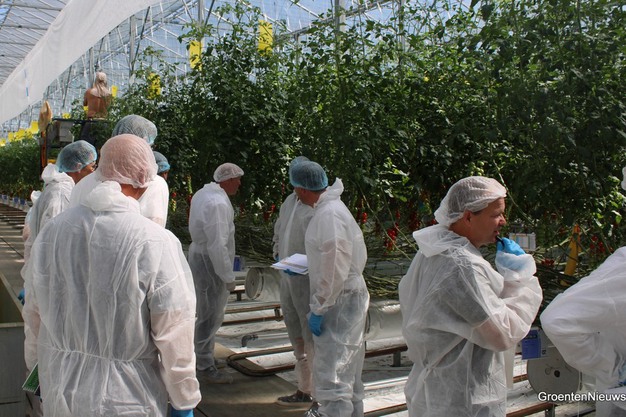 A tour of the demo greenhouse
A tour of the demo greenhouse
Confident in high resistance
Will HREZ become the next Tm-22? This was the question with which Crop Breeding Manager Martijn van Stee opened his presentation in the first afternoon session. His answer, given early in the presentation, was a resounding "yes." He then explained why in front of around 30 attendees, also sharing lessons learned over the past year.
The HREZ gene, which Enza Zaden claims provides high resistance to ToBRFV, belongs to the same family as the Tm-22 gene. Its mode of action, based on a hypersensitivity reaction, is also similar. "The Tm-22 gene has long been regarded by the entire industry as the gene that ensures high resistance to TMV, ToMV, and ToMMV," Martijn stated, illustrating why Enza Zaden is so confident in the ToBRFV-resistant gene they have successfully introduced into an increasing number of varieties.
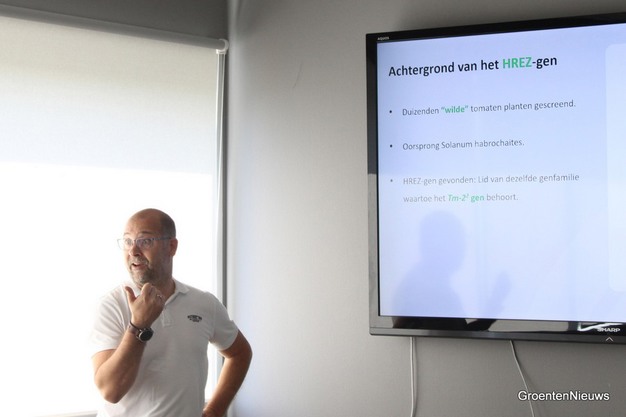
Martijn van Stee elaborated on the search for a resistant gene.
Coarser, more vigorous and higher brix
One concern among breeders at Enza Zaden was that the gene, derived from wild tomato material, might introduce "genetic drag"—a breeder's term for unwanted traits from wild tomatoes in commercial varieties.
At Enza Zaden, they succeeded in isolating only the resistance gene, with just "a little bit" of the wild source. "We crossed in as little of the wild source as possible. Because we are working with a single dominant gene, we were able to accelerate the breeding process."

Willem van der Knaap with the Bronski variety
Once in the greenhouse, some of those 'wild' traits reappeared, often in a positive way. Willem van der Knaap demonstrated that some varieties are just a bit coarser or more vigorous than their non-resistant predecessors. The Bronski variety, for example, turned out to be slightly coarser than its predecessor Bronsino. "In Belgium, Bronski is the benchmark in the Elite segment," he said.
In the cocktail segment, the Annico Cove variety has become stronger, while Shivious also benefits from the positive elements of the wild material from which the resistance originates. Another variety in this segment, Montague, has a higher brix. "We have nothing to complain about in the cocktail segment," observed the man responsible for bringing the most promising varieties from Enkhuizen to the demo greenhouse in Pijnacker.
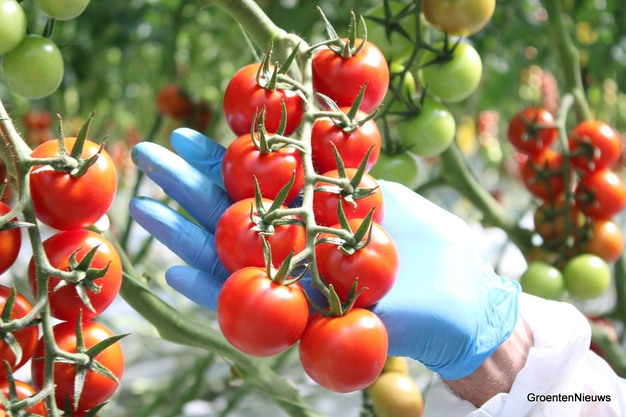
Shivious
Rootstocks
Three years after the introduction of the first resistant varieties, Enza Zaden now offers HREZ varieties in all tomato segments. Two resistant rootstocks are also available (Stromboli and EZ 3290).
During the session, Martijn took special note of these rootstocks. The breeder advocates for the combination of a resistant upper stem and a resistant rootstock for optimal resistance to ToBRFV. "It is no coincidence that all rootstocks have Tm-22 resistance," he explained.
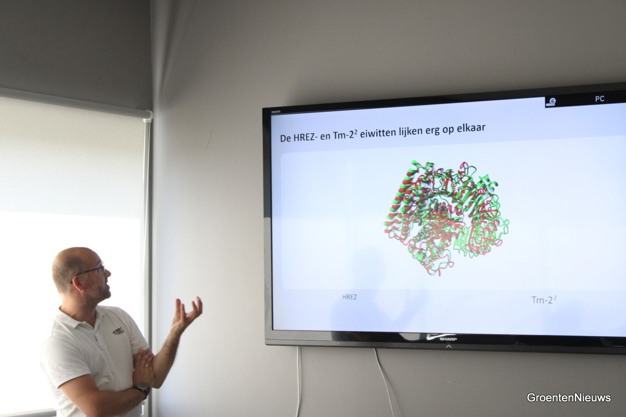
Martijn shows that Enza Zaden's HREZ gene and the Tm-22 gene are very similar.
Not necessarily required
At present, Enza Zaden does not have enough HREZ rootstocks available for the entire market. In Dutch substrate cultivation, it has been shown that at low virus pressure, a resistant rootstock is not necessarily required, provided overall hygiene is maintained. "In Sicily, where the soil is full of the virus and they grow in the soil, a resistant rootstock is even more important. The higher the virus pressure in the soil or substrate, the more relevant a resistant rootstock becomes." Just like with the upper stems, the range of HREZ rootstocks will continue to evolve. "Our variety flow has accelerated tremendously in the last two years," he added.
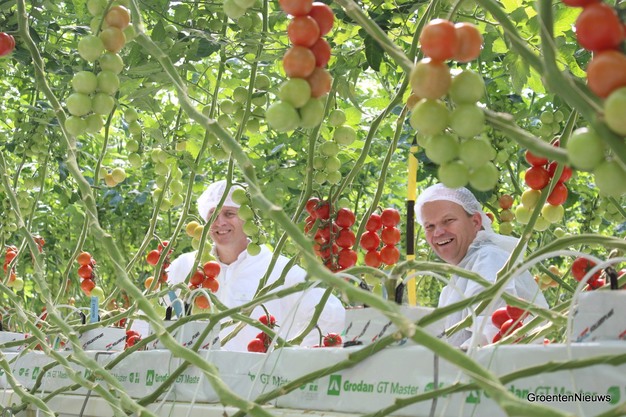
Tomato watching - always fun, isn't it, Franky van Looveren?
Lessons learned
One of the lessons Enza Zaden has learned over the past year is that spontaneous mutants of the ToBRFV virus can occur. Currently, the company is aware of a few breakthrough strains. In these cases, virus symptoms can be seen on the first plant, but the virus spreads very little, Martijn explained. "This is because the mutation occurs in the part of the gene responsible for movement," he said.
He referred to this as a "fitness penalty." The result is a "crippled virus" after mutation, which is not detected properly by the patented Enza gene. In trials and in practice, Enza Zaden observed the virus spreading to 50 to 100 plants. "After that, the virus dies out," he said. Nevertheless, the advice remains to always remove infected plants immediately.
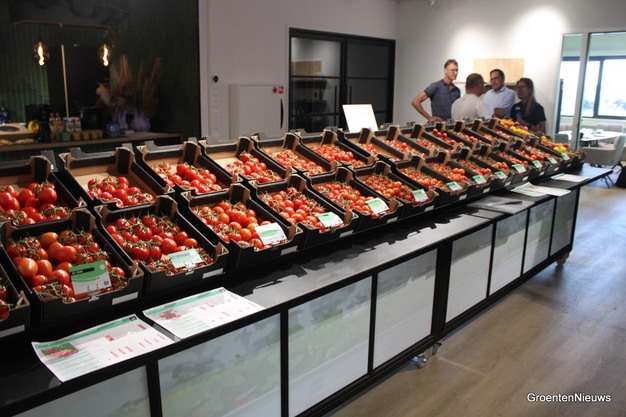
Plenty of choice, and plenty of material to catch up on with growers, plant breeders and also the trade.
At this point in the presentation, more questions arose from the audience. There was discussion about mutations that occur spontaneously and then stop spreading. According to Enza Zaden, mutations of the ToBRFV virus that arise or spread in a non-natural way is a path that should not be taken.
Other lessons from Enza Zaden's research indicate that virus particles are also present in HREZ varieties. However, the amount is over a million times less compared to susceptible plants under normal virus pressure, and HREZ plants are not infectious. For Enza Zaden, this is proof of the strength of their HREZ resistance, although the company continues to emphasize that growers must remain vigilant about hygiene.

Frank van Antwerpen with the varieties Icaria and Fraser Paradise. Varieties in which Enza Zaden scored well in consumer research.
New varieties
After Martijn's presentation, the group split into two. Those who wanted to see both the plants and the fruit headed to the greenhouse. "Just to see how the crop managed through the hot period here," one visitor noted. Another group stayed upstairs, above the 'shelves' filled with tomato varieties, including HREZ heirloom tomatoes for the first time. "This is an incredibly popular segment in France," said Frank van Antwerpen. "Even with the chunkier tomatoes, they really focus on flavor here."
In the Netherlands, the focus on flavor is mainly in the finer segment, noted the Product Manager Tomato Heated West Europe in the Dutch tomato chain. With Fraser Paradise and Icaria, Enza Zaden has two new HREZ varieties that score well in this area. "We had our varieties compared with reference varieties in consumer surveys. In all three surveys, consumers overwhelmingly chose our variety."

The new HREZ heirloom tomatoes. One of the latest HREZ additions to the range.
For more information:
Enza Zaden
+31 (0)228 350100
[email protected]
www.enzazaden.com
